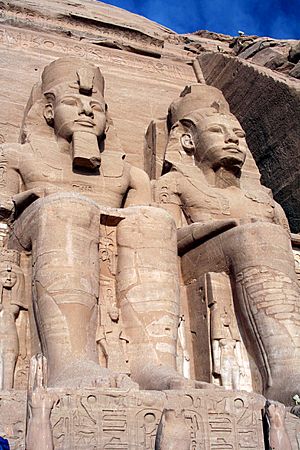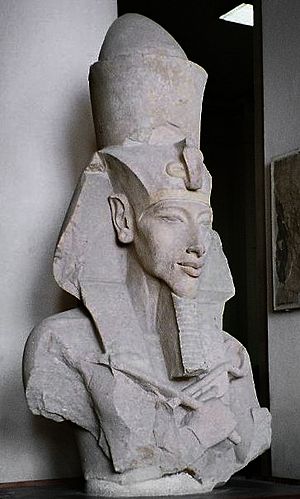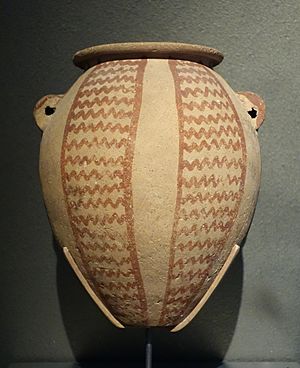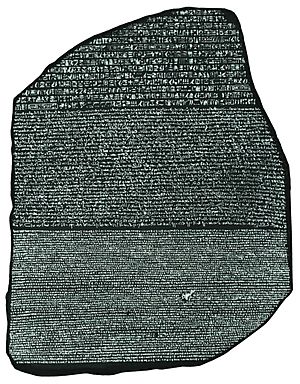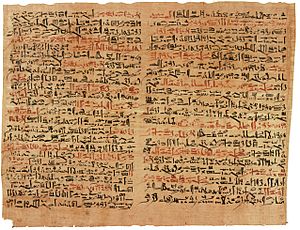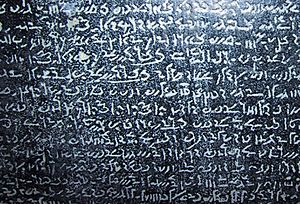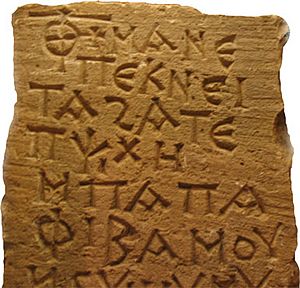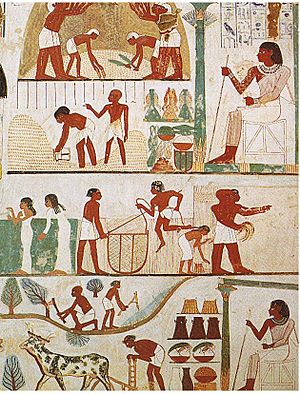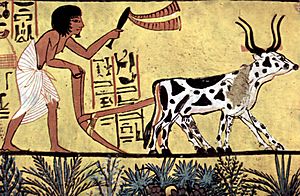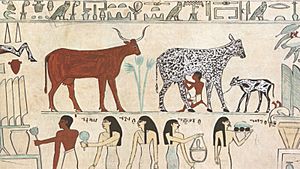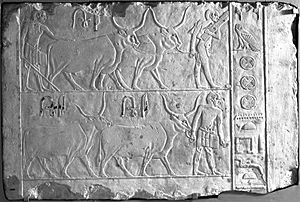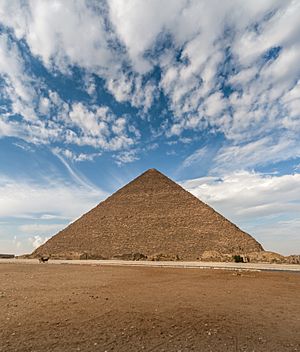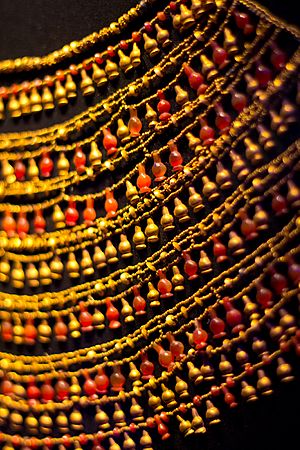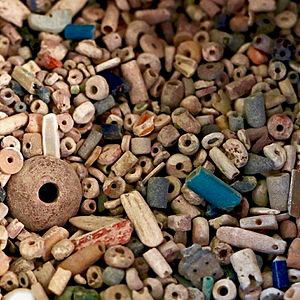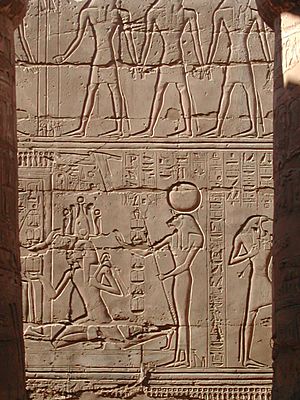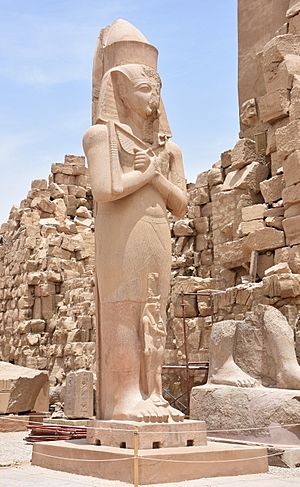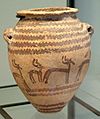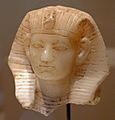Ancient Egypt facts for kids
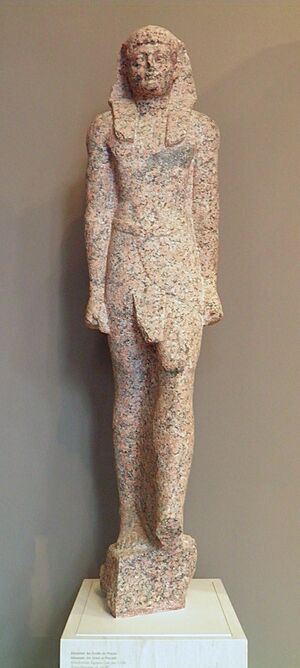
Ancient Egypt was a powerful civilization that began around 3150 BC (Before Christ). It lasted for thousands of years until 30 BC, when the Roman Empire took control. This amazing society grew along the River Nile. It was strongest around 1000 BC.
Ancient Egypt stretched from the Nile delta in the north to Nubia in the south. Nubia is a kingdom that is mostly in modern-day Sudan. For most of its history, Egypt was rich and successful. This was thanks to the Nile River, which provided water for good crops. Farmers grew crops after the yearly floodwaters went down.
The Egyptians created a special way of writing called hieroglyphs. They built huge temples and tombs. They also traded with other lands and had a strong army. Their religion involved many gods, and the priests were very powerful and wealthy. Their rulers, called Pharaohs, were believed to be very close to the gods.
Ancient Egyptians achieved many incredible things. They developed ways to quarry, survey, and build huge structures. These skills helped them create monumental pyramids, temples, and obelisks. They also had a system of mathematics and a very good medical system. They built irrigation systems for farming and made the first known planked boats.
They also invented Egyptian faience (a type of pottery) and glass technology. They created new kinds of literature. They even signed the earliest known peace treaty with the Hittites.
Ancient Egypt has left a lasting mark on the world. Its art and architecture were copied by many. Many of its ancient treasures were taken to far-off places. Its huge ruins have inspired travelers and writers for hundreds of years. In more recent times, people started to study Egyptian civilization scientifically. This led to the field of Egyptology, helping us understand their culture even better.
Contents
History
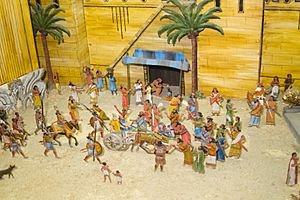
Archaeologists study objects left by ancient people. They have found that people lived along the Nile River for a very long time. The fertile land near the Nile floods allowed people to start farming. By 10,000 BC, people in Egypt began growing cereal grains like wheat and barley.
Because they were farming, they stayed in one place. This led to their society becoming more complex. This was a big step in human civilization. This early time in Egyptian history is called predynastic. It happened before the large dynastic kingdoms were formed.
Around 5500 BC, small groups living in the Nile valley grew into different cultures. Each group started farming crops and animals. They also had their own types of pottery and personal items. These included combs, bracelets, and beads.
In Upper Egypt, which is the southern part of the country, the Badarian was one of the earliest cultures. It is known for its high-quality pottery, stone tools, and use of copper. The Amratian and Gerzian cultures followed them.
The different periods of ancient Egyptian history are:
- Predynastic Period (5500 – 3000 BC)
- Early Dynastic Period (1st & 2nd Dynasties, 3000 – 2700 BC)
- Old Kingdom (3rd to 6th Dynasties, 2700 – 2180 BC)
- First Intermediate Period (7th to 11th Dynasties, 2180 – 2050 BC)
- Middle Kingdom (11th to 14th Dynasties, 2080 – 1640 BC)
- Second Intermediate Period (15th to 17th Dynasties, 1640 – 1560 BC; the Hyksos)
- New Kingdom (18th to 20th Dynasties, 1560 – 1070 BC)
- Third Intermediate Period (21st to 25th Dynasties, 1070 – 664 BC)
- Late Period (26th to 31st Dynasties, 664 – 323 BC; the Persians)
- Graeco-Roman Egypt (323 – 30 BC; Ptolemaic to Roman)
The "Intermediate periods" were times when the usual government system broke down. The country might have been split into parts or invaded by foreign rulers. During these times, the government faced challenges and was sometimes overthrown.
Government
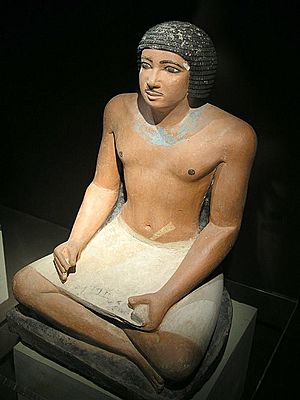
Ancient Egypt was divided into many districts called sepats. These divisions first appeared during the Predynastic Period. Back then, they were small city-states that ruled themselves. When the first pharaoh came to power, the sepats remained. They were much like the counties we have today.
These districts stayed mostly the same for a long time. There were 42 of them. Each was ruled by a governor chosen by the pharaoh. Later, these districts were called nomes, and the governor was called a nomarch.
Ancient Egypt had many different taxes. However, there was no real money. So, people paid each other with goods or work. A scribe was the person who watched over tax collection. Every tax collector had to report daily how much they had collected.
Each person paid different taxes based on their work. Craftsmen paid with goods. Hunters and fishermen paid with food. Every household in the country had to pay a labor tax each year. This meant helping with work for the country, like mining or digging canals. Many rich Egyptians paid poorer people to do this work for them.
Language and Writing
Language
The Egyptian language changed over six main time periods:
- Archaic Egyptian (before 3000 BC). This language is found on carvings on pottery.
- Old Egyptian (3000 BC to 2000 BC). This language was used during the Old Kingdom and First Intermediate Period. It is found in pyramids, which are Egyptian tombs. This was the first version of the language to have a plural tense, showing more than one object.
- Middle Egyptian (2000 BC to 1300 BC). This language is called Classic Egyptian. It is found on many objects and tombs, including Egyptian coffins. Books about science and society were written during this time. Much of what we know about their religion is written in Classic Egyptian. Even after people stopped speaking it, writers still used it for books.
- Late Egyptian (1300 BC to 700 BC). This is the language of the New Kingdom, which was a very successful time for Egypt. A lot of knowledge was shared then, so we have many old books written in Late Egyptian. Many believe this version was very similar to what Egyptians actually spoke.
- Demotic Egyptian (700 BC to 400 AD)
- Coptic Egyptian (300 AD to 1700 AD)
Writing
Hieroglyphics
Egypt had a writing system called hieroglyphics. It is one of the two oldest written languages, along with Sumerian cuneiform. Hieroglyphic writing started around 3200 BC and uses about 500 symbols. A hieroglyph could represent a word or a sound. The same symbol could be used for different things depending on the situation. Hieroglyphs were used for public purposes, like on stone monuments and in tombs. It was also a form of art and often used for political messages.
Hieratic script
This script was used by priests for everyday writing. They wrote on papyrus, wood, or cloth. For daily writing, scribes used a faster, flowing style called hieratic. While formal hieroglyphs could be read in rows or columns, hieratic was always written from right to left, usually in horizontal rows.
Demotic script
This script was used by ordinary people. Demotic became the main writing style. This form of writing, along with formal hieroglyphs, appears with the Greek text on the Rosetta Stone.
Coptic script
The Coptic script is a changed version of the Greek alphabet. The Coptic language is the last stage of the ancient Egyptian language. Modern Egyptians speak a dialect of Arabic.
Religion
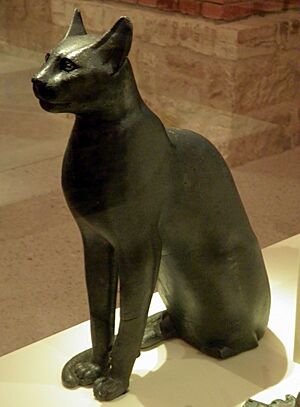
Religion was extremely important to Ancient Egyptians. They believed animals were holy and worshiped them. Because of this, Egyptians tamed animals very early and took great care of them.
The temple was the center of any Egyptian town. This building was used for many things, from a town hall to a university, in addition to its religious services. Because they were so religious, Egyptians created a lot of art showing their gods. This art shows many different kinds of holy beings, including the pharaoh, who was thought to be a god.
The afterlife was also very important to Egyptians. They are famous for mummifying their dead. These mummies are important to scientists today because they teach us about how the Egyptians lived. All the gods were important, but some were more important than others.
Agriculture
The rich, fertile soil came from the yearly floods of the Nile River. This allowed ancient Egyptians to grow a lot of food. With plenty of food, people had more time and resources for cultural, technological, and artistic activities. In ancient Egypt, taxes were based on how much land a person owned.
Farming in Egypt depended on the Nile River's cycle. Egyptians recognized three seasons: Akhet (flooding), Peret (planting), and Shemu (harvesting). The flooding season lasted from June to September. It left a layer of mineral-rich silt on the riverbanks, perfect for growing crops. After the floodwaters went down, the growing season lasted from October to February. Farmers plowed and planted seeds in the fields. These fields were irrigated with ditches and canals.
Egypt received little rainfall, so farmers relied on the Nile to water their crops. From March to May, farmers used sickles to harvest their crops. The crops were then threshed with a flail to separate the straw from the grain. Winnowing removed the chaff from the grain. The grain was then ground into flour, brewed to make beer, or stored.
Flax plants were grown for the fibers in their stems. These fibers were split and spun into thread. This thread was used to weave linen sheets and make clothing. Papyrus grew along the Nile and was used to make paper.
Vegetables and fruits were grown in garden plots. These were close to homes and on higher ground, and had to be watered by hand. Vegetables included leeks, garlic, melons, squashes, pulses, lettuce, and other crops. They also grew grapes, which were made into wine.
Animals
Egyptians believed that a balanced relationship between people and animals was key to the world's order. They thought humans, animals, and plants were all part of one whole. Cattle were the most important livestock, and livestock were taxed. Besides cattle, ancient Egyptians kept sheep, goats, and pigs.
Poultry like ducks, geese, and pigeons were caught in nets and raised on farms. The Nile provided many fish. Bees were also kept from at least the Old Kingdom, providing both honey and wax.
Ancient Egyptians used donkeys and oxen as working animals. They plowed fields and helped plant seeds. Horses were brought in during the Second Intermediate Period. The camel, though known from the New Kingdom, wasn't widely used until the Late Period. There's also some evidence that elephants were used briefly in the Late Period. However, they were mostly given up because there wasn't enough grazing land for them.
Dogs, cats, and monkeys were common family pets. More unusual pets, like lions, were brought from Africa and kept only by royalty. The ancient Greek writer Herodotus noted that Egyptians were the only people who kept their animals inside their homes. During the Predynastic and Late periods, worshiping gods in animal form was very popular. Examples include the cat goddess Bastet and the ibis god Thoth.
Medicine
Ancient Egyptians had advanced medical knowledge for their time. They performed surgery, set broken bones, and even knew about medicines. They believed their medicines had healing powers. They also thought their gods could protect them from evil spirits and demons.
To see how good they were at medicine, we can look at the medical papyri that still exist today. The Edwin Smith papyrus is the world's oldest surviving surgical document, from about 1600 BC. This text describes human anatomy. It also details the examination, diagnosis, treatment, and outlook for 48 different medical problems.
Pyramids
Ancient Egyptian pyramids are huge stone structures. They are the most famous pyramid buildings and some of the largest ever built. Over 130 pyramids have been found in Egypt. Most were built on the western side of the Nile River, in desert areas.
Egyptian pyramids often contain chambers and passages inside. The pyramids were built as burial places for Egyptian kings. They were used from before the start of the Old Kingdom until the end of the Middle Kingdom. Because Egyptians kept written records, we know how some pyramids were built.
The Great Pyramid at Giza is the largest and most famous pyramid. It was built for Pharaoh Khufu. It is over 140 meters (460 feet) high and took 20 years to build. It is listed as one of the Seven Wonders of the World.
The step pyramid at Saqqara is the earliest pyramid that is still standing today. This was built in 2630 BC. It was the burial place of Pharaoh Djoser. The architect of the step pyramid was Imhotep.
Other Achievements
Engineering was a very important activity in Egypt. Engineers could measure and survey the distance between two points. They designed and built the pyramids, which are almost perfectly shaped. They could make cement and developed large irrigation networks.
Science was also important. Mathematics was used in Egypt. The golden ratio was used in the construction of the Pyramids.
Another skill of the Egyptians was glass making. Archaeologists have found many pieces of beads, jars, figures, and ornaments in tombs across the country. In 2005, the remains of an ancient glass-making factory were found.
Timeline
Predynastic
- 3500 BC: Senet, a board game, is invented.
- 3500 BC: Faience, the world's oldest earthenware (a type of pottery), is created.
Dynastic
- 3300 BC: Bronze items are first made.
- 3200 BC: Hieroglyphs are developed.
- 3100 BC: The Decimal system is in use.
- 3100 BC: Mining takes place on Mount Sinai.
- 3100 BC: Ships are built in Abydos, an Egyptian city.
- 3000 BC: Trading happens between Egypt and Palestine.
- 3000 BC: Copper plumbing is in use.
- 3000 BC: Papyrus, an ancient form of paper, is first used.
- 3000 BC: First recorded use of medicine.
- 2900 BC: Perhaps the first use of steel in the ancient world.
- 2700 BC: First surgery performed.
- 2700 BC: Surveying used by engineers.
- 2700 BC: Hieroglyphs start to represent sounds, not just pictures of words.
- 2600 BC: The Great Pyramids of Giza are created.
- 2600 BC: Shipping expeditions take place.
- 2600 BC: First use of barges.
- 2600 BC: Pyramid of Djoser is created.
- 2600 BC: Menkaure's Pyramid and the Red Pyramid are created.
- 2200 BC: The government in Egypt collapsed, leading to many people trying to become King.
- 1900 BC: A possible Nile to Red Sea canal is created.
- 1650 BC: The Rhind Mathematical Papyrus is written, showing knowledge of geometry, arithmetic, and algebra.
- 1600 BC: The Edwin Smith Papyrus is written, showing knowledge of advanced medical techniques.
- 1550 BC: The Ebers Medical Papyrus is written, the first document about tumours.
- 1500 BC: Glassmaking begins.
- 1258 BC: First known peace treaty (by Ramesses II).
- 1160 BC: The Turin Papyrus is written, the first geologic and topographic map.
Related pages
Images for kids
-
The pyramids of Giza are among the most recognizable symbols of ancient Egypt.
-
Early tomb painting from Nekhen, around 3500 BC, Naqada, possibly Gerzeh, culture.
-
The Narmer Palette shows the unification of the Two Lands.
-
Khafre enthroned.
-
Statues of two pharaohs of Egypt's Twenty-Fifth Dynasty and several other Kushite kings. From left to right: Tantamani, Taharqa (rear), Senkamanisken, again Tantamani (rear), Aspelta, Anlamani, again Senkamanisken. Kerma Museum.
-
Assyrian siege of an Egyptian fortified city, a scene from the Assyrian conquest of Egypt, likely showing the capture of Memphis in 667 BC. Sculpted in 645–635 BC, under Ashurbanipal. British Museum.
-
Portrait of Ptolemy VI Philometor wearing the double crown of Egypt.
-
Hieroglyphs on a stela in Louvre, around 1321 BC.
-
Ostrakon: hunting a lion with a spear and dog.
-
Ruins of Deir el-Medina. A UNESCO World Heritage Site.
-
The Book of the Dead was a guide for the deceased's journey in the afterlife.
-
Anubis was the ancient Egyptian god linked to mummification and burial rituals; here, he attends to a mummy.
-
An Egyptian chariot.
-
Astronomical chart in Senemut's tomb, 18th dynasty.
-
The Temple of Dendur, completed by 10 BC, made of aeolian sandstone, temple proper: height: 6.4 m, width: 6.4 m; length: 12.5 m, in the Metropolitan Museum of Art (New York City).
-
Illustration of various types of capitals, drawn by the Egyptologist Karl Richard Lepsius.
-
Kneeling portrait statue of Amenemhat holding a stele with an inscription; around 1500 BC; limestone; Egyptian Museum of Berlin (Germany).
-
Fresco which shows Nebamun hunting birds; 1350 BC; paint on plaster; 98 × 83 cm; British Museum (London).
-
Portrait head of pharaoh Hatshepsut or Thutmose III; 1480–1425 BC; most probably granite; height: 16.5 cm; Egyptian Museum of Berlin.
-
Frontispiece of Description de l'Égypte, published in 38 volumes between 1809 and 1829.
-
Tourists at the pyramid complex of Khafre near the Great Sphinx of Giza.
See also
 In Spanish: Antiguo Egipto para niños
In Spanish: Antiguo Egipto para niños


